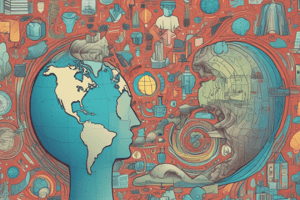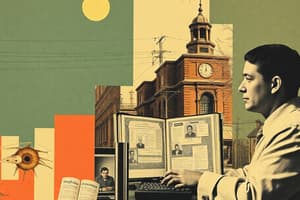Podcast
Questions and Answers
Which statement best defines economics according to Lionel Robbins?
Which statement best defines economics according to Lionel Robbins?
- Economics is the study of how societies use scarce resources.
- Economics is the science of wealth.
- Economics studies human behavior relative to ends and scarce means. (correct)
- Economics is a method rather than a doctrine.
What aspect of economics does microeconomics primarily focus on?
What aspect of economics does microeconomics primarily focus on?
- Analysis of national unemployment rates.
- Overall monetary policies.
- Large-scale economic phenomena.
- Individual and business decisions. (correct)
Which of the following is NOT a broad area of microeconomics?
Which of the following is NOT a broad area of microeconomics?
- Consumer Behaviour
- Market Structures
- Labour Economics
- National Income Accounting (correct)
What is the primary method used in microeconomics to illustrate complex economic relationships?
What is the primary method used in microeconomics to illustrate complex economic relationships?
Which definition comes closest to describing economics as a technique of thinking?
Which definition comes closest to describing economics as a technique of thinking?
What does a positive slope in a graph signify about the relationship between X and Y?
What does a positive slope in a graph signify about the relationship between X and Y?
Which shape represents a graph with a negative slope?
Which shape represents a graph with a negative slope?
In the context of equations, what does the term 'Qd' represent in the linear equation $Qd = a - bP$?
In the context of equations, what does the term 'Qd' represent in the linear equation $Qd = a - bP$?
What does a zero slope on a graph indicate?
What does a zero slope on a graph indicate?
When integrating a marginal cost function, what do you obtain?
When integrating a marginal cost function, what do you obtain?
Flashcards
Microeconomics
Microeconomics
Study of individual and firms decisions on resource allocation.
Scarcity
Scarcity
Limited resources, unmet wants.
Opportunity Cost
Opportunity Cost
Value of forgone alternative to a chosen option.
Elasticity of Demand
Elasticity of Demand
Signup and view all the flashcards
Market Equilibrium
Market Equilibrium
Signup and view all the flashcards
Positive Economics
Positive Economics
Signup and view all the flashcards
Normative Economics
Normative Economics
Signup and view all the flashcards
Circular Flow
Circular Flow
Signup and view all the flashcards
Allocative Efficiency
Allocative Efficiency
Signup and view all the flashcards
Market Structure
Market Structure
Signup and view all the flashcards
Study Notes
Overview of Microeconomics
- Microeconomics studies individual and business decisions related to the allocation of scarce resources.
- Key areas include consumer behavior, production costs, market structures, market failures, labor economics, game theory, welfare economics, and behavioral economics.
- Distinct from macroeconomics, which examines the economy as a whole through national income, business cycles, and overall fiscal policies.
Definitions of Economics
- Adam Smith: Focuses on wealth.
- Alfred Marshall: Emphasizes human behavior in daily life.
- Lionel Robbins: Defines economics in terms of ends and scarce means.
- John Maynard Keynes: Describes it as a method of thinking.
- Paul A. Samuelson: Centers on societal use of scarce resources.
Understanding Graphs
- Economics heavily utilizes graphs to illustrate relationships, simplify problems, and identify patterns.
- Types of slopes in graphs include positive (both variables increase), negative (one variable increases while the other decreases), and constant (no change).
- Slope indicates relationship strength but differs from elasticity, which measures relative change.
Mathematical Foundations
- Linear Equations: Qd = a - bP; Qs = a + bP.
- Non-linear Equations: Q = AKαLβ; TC = F + bQ + cQ².
- Differentiation applies to marginal analysis (MC, MR, MU) while integration helps determine total values.
Elasticity Concepts
- Price Elasticity of Demand (Ed): Measures responsiveness of quantity demanded to price changes.
- Cross-price, Income Elasticity of Demand show how changes in price or income affect demand.
- Elasticity is unitless and varies along a demand curve, unlike slope, which is constant.
Positive vs. Normative Economics
- Positive Economics describes actual functioning of the economy (e.g., minimum wage impacts).
- Normative Economics prescribes desired economic policies (e.g., should increase minimum wage).
- Economic models help in forecasting and counterfactuals, including endogenous (inside the model) and exogenous (outside the model) variables.
Key Economic Agents
- Consumers: Demand goods/services, own production factors.
- Firms: Supply goods/services, influence markets through production.
- Government: Regulates economy and implements policies for market intervention.
Circular Flow of Income
- Represents economic transactions in a two- or three-sector economy with households, firms, and governments.
- Illustrates real flows (goods/services) versus money flows (financial transactions).
Applications of Microeconomics
- Pricing Strategies: Firms determine pricing to optimize profits.
- Consumer Behavior: Insights into decision-making processes.
- Market Structures: Analysis of competition levels ranging from perfect competition to monopolies.
- Public Policy: Strategies for government intervention in correcting market failures.
Scarcity and Opportunity Cost
- Scarcity arises from limited resources against unlimited wants.
- Opportunity cost reflects the value of the next best alternative forfeited in decision-making.
Efficiency in Economics
- Allocative Efficiency: Resource allocation that meets consumer desires at minimal cost.
- Inefficiency occurs when resources are dedicated to unwanted goods/services. Examples highlight inefficiency when resources are misallocated (e.g., producing meat for a vegetarian society).
Market Equilibrium
- An efficient economy balances supply and demand, leading to optimal resource allocation for desired goods/services.
Studying That Suits You
Use AI to generate personalized quizzes and flashcards to suit your learning preferences.




